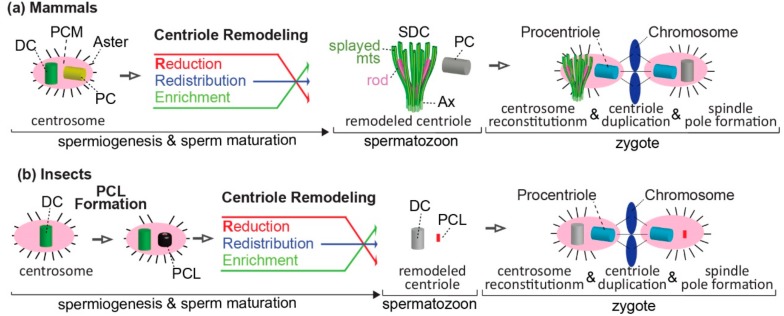Figure 5.
Mechanisms of atypical centriole formation in mammals and insects. (a) Model of centriole remodeling that transforms the typical centriole to an atypical centriole, and the role of sperm centrioles in the zygotes of non-rodent mammals. The early spermatid centrosome is made of two typical centrioles (PC and DC) and pericentriolar material (PCM) that form an aster. During spermiogenesis, centrosomal proteins are redistributed, and their amount is altered (reduced or enriched). Consequently, the DC is remodeled and forms an atypical centriole: the spermatozoon distal centriole (SDC). The SDC is made of rods and splayed microtubules (mts), which are attached to the core of the flagellum (axoneme, Ax) in the mature spermatozoon. The PC remains structurally typical, but it has an atypical protein composition. After fertilization, both the typical and atypical centrioles recruit maternal PCM and reconstitute the zygote centrosome. Later, these typical and atypical centrioles separate and each form a centrosome, an aster, a new centriole (procentriole), and a spindle pole at distinct stages of zygote development. (b) Model of atypical centriole formation, followed by centriole remodeling, and the role of sperm centrioles in the zygote of insect. The early spermatid centrosome consists of a single centriole that becomes distal centriole (DC). The DC is surrounded by PCM and forms an aster. During early spermiogenesis, an atypical centriole forms: the PCL. During mid and late spermiogenesis, centrosomal proteins are redistributed, and their amount is altered (reduced or enriched). Consequently, the DC protein composition is remodeled, but it maintains a centriole wall made of microtubules, which are attached to the core of the flagellum (axoneme, Ax) in the mature spermatozoon. The PCL is modified structurally and compositionally. After fertilization, both the DC and PCL recruit maternal PCM and reconstitute the zygote centrosome, which later forms an aster, a new centriole (procentriole), and a spindle pole at distinct stages of zygote development.

